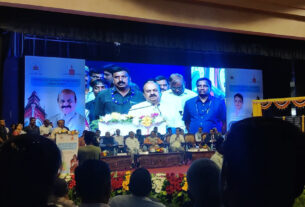Artificial limbs with the latest technology can be priced in lakhs which puts them out of reach of most people.
If you sit in the waiting area of Mobility India for a while, you will notice the vibrant shades of lime green, peach, and light pink walls and bright yellow pillars, ramps instead of stairs and you can hear a soft murmur. Everything to make sure the visitors are comfortable. Visitors include patients and their family members. A child that has to be carried by her father for physical therapy or a woman that sits with a prosthetic leg in a bag kept at her feet.
People belonging to the disabled community often need to pay a hefty price for essential support that enables them to live an ordinary life. Amputees often need to spend a small fortune on prosthetics that would replace their limbs—anywhere from a few thousand to about Rs. 25 lakhs.
A parent of a patient at Mobility India said that the big price tag makes sense only if the product is of high quality. The price depends on the type of prosthetic. The most challenging, and therefore the most expensive is the prosthesis that replaces the portion of the leg from above the knee.
As Ashok Shankar, owner of New Bangalore Artificial Limbs Centre, explained, for above knee prosthetics, the knee needs to be replaced. The function of a natural knee needs to be recreated by the artificial limb which is difficult to achieve and thus costlier to make. Compared to Rs. 26,000 for a below knee prosthetic, Shankar said that an above knee one can cost as much as Rs. 72,000. These are some of the cheaper alternatives that are available in the market.
Dr Nabil Ahmed (Prosthetics & Orthotics), Founder of Cyborg Future, pointing at a black arm prosthetic said that an average arm prosthetic with the new technology can cost around Rs. 3 – 3.5 lakhs. The carbon fibre covering on the exterior of the arm itself will cost quite a lot. Dr Ahmed clarified that they have been working on a (Direct to consumer) D2C model since the launch of the company. They have been successful in bringing down the cost of the same prosthetic to around Rs. 1.8 to 2.5 lakhs.
Dr Ahmed said that it was a myth that prosthetics are expensive, there are cheaper alternatives available that are generally offered by indigenous companies. He explained that there are three categories of prosthetics manufacturers — the third segment, smaller companies that locally produce artificial limbs using cheap and locally found materials; the second one where start ups create cheaper models using new technology like 3D printing; finally, the last segment where the big international companies come into play with their global production and marketing base.
Sanjoy Singh, Assistant General Manager P & O Service at Mobility India said that high-end prosthetics come from countries such as China, Germany, the United Kingdom, the United States of America and France. The cost of these can be as high as Rs. 21 – 25 lakhs. Dr Ahmed added to it by saying that the high price of the products is because of the benefits that come with it. The price also depends on the specifications and needs of the individual.
Dr Ahmed gave the example of a diabetic patient and said that the patient could experience fluctuations in the swelling of his or her stubs which require modifications like gel liner or inner liner in the prosthesis. Also, certain products are expensive because a lot of research has gone into making them user-friendly and the company can be held accountable for any accidents. Part of the research involves testing such as ISO (International Organization for Standardization) test, Singh said. Singh continued that the Indian prosthesis market is very limited right now with only a few regional producers.
‘Kadam’ is an Indian prosthesis developed by the Indian Institute of Technology Madras with input from the Society for Biomedical Technology (SBMT) and Mobility India. The above knee ISO-tested prosthesis allows the amputee to have stability and work comfortably. This technology is at a very early stage with very few users. But, Singh said, “We are working on the last few checks and rectifications and we hope to bring Kadam into the market very soon.”
Till now, Mobility India has shared the TOT (Transfer of Technology) with four national colleges — National Institute for Locomotor Disabilities (NILD), Kolkata, Swami Vivekanand National Institute of Rehabilitation Training and Research (SVNIRTAR), Olatpur in Odisha, All India Institute of Physical Medicine and Rehabilitation (AIIPMR), Mumbai and National Institute for Empowerment of Persons with Multiple Disabilities (NIEPMD), Muthukadu in Tamil Nadu; and a hospital — Tirupati Birrd Hospital.
Singh said that Mobility India works for the poor and needy but there is a limit to how much they can help. Providing any kind of help largely depends on the funds they have. “The group cannot provide help unless they have money to do so, despite getting requests,” Singh added. Arranging for concessions is not a regular occurrence. Shankar said that he can only offer a maximum subsidy of Rs. 2000 – Rs. 3000 on a purchase of Rs. 30,000.
Dr Ahmed said that reducing the cost of production of a prosthetic by a large margin would be difficult. This is because raw materials need to be imported to maintain the quality of the product. Cyborg Future imports most of its raw materials from Switzerland and Europe as they have the required machinery. “Trying to bring that machinery to India will not be practical because it involves nanotechnology and trained professionals,” said Dr Ahmed, “buying the materials will be cheaper.”
Fortune Business Insights has compiled information about the prosthetics market which predicts that the market will grow from $1.61 billion in 2022 to $2.33 billion by 2029, at a Compound Annual Growth Rate (CAGR) of 5.4 percent. Compared to 2019, the market experienced a decline of 6.3 percent in 2020 as a result of COVID-19.




